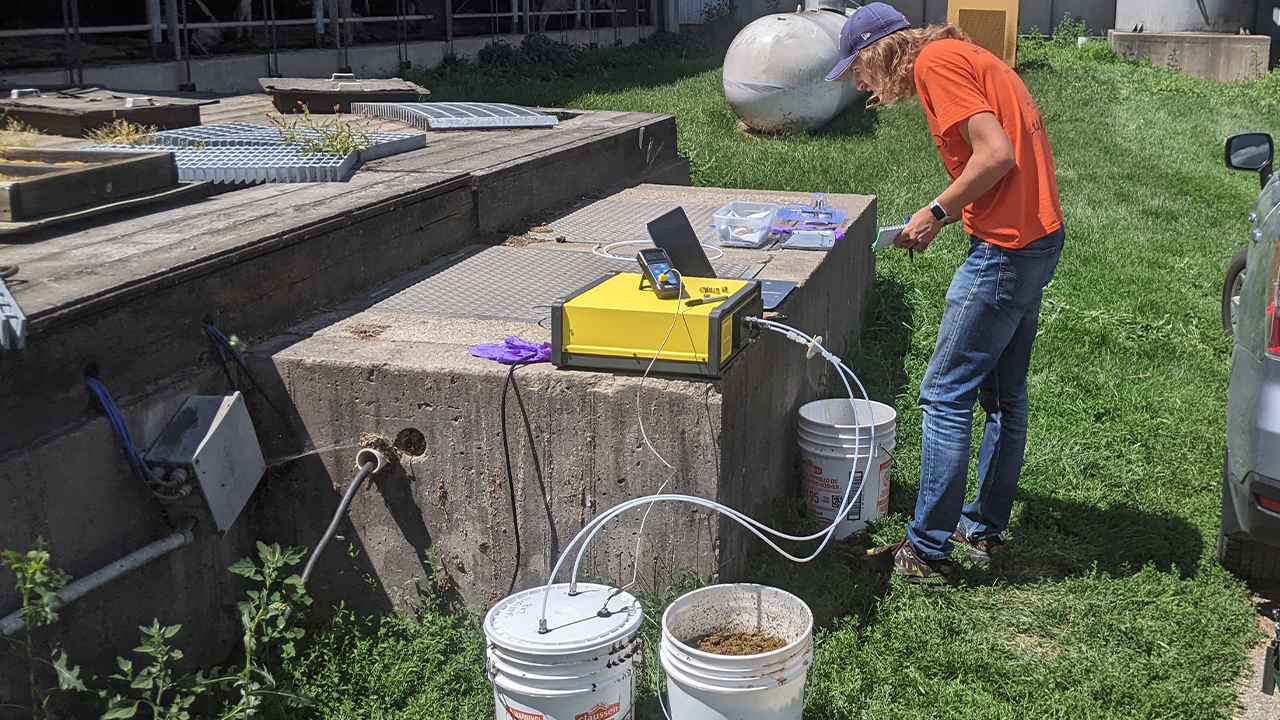Three University of Wisconsin-Platteville students are looking at biochar as a way to reduce ammonia emissions and odors off of manure storages, which many farms in Wisconsin use.
According to the students’ research, manure storages are good for many environmental reasons, but are also a source of odor and greenhouse gas emissions. Jeffrey Smolinski, Zach Flitsch and Davin Dahl wanted to look at using biochar as a cover over the manure to reduce emissions. Biochar, which looks similar to charcoal, is a carbon-based material produced by heating biomass at high temperatures with limited oxygen.
Smolinski, a New London, Wisconsin, native, said the trio chose this topic based off of Dr. Joseph Sanford’s research focus at the time. Sanford, the group’s project mentor, is a Dairy Innovation Hub researcher focused on agricultural waste management who has many ongoing projects related to manure. The group started the project in late August with greenhouse gas readings and continued through mid-January.
Smolinski, Flitsch and Dahl collected manure from Pioneer Farm and placed it in multiple five-gallon buckets at the farm. They left some of the buckets alone, similar to what happens at most manure storages. They added different types of biomass covers to the rest. In the first trial, the group used wood chips and corn stover as covers on some of the buckets, while others received biochar made out of wood chips or corn stover. For six months, they measured the gas emissions of carbon dioxide, methane, nitrous oxide and ammonia off the buckets once a week after they were filled and the covers were laid in order to determine the impact the covers had.
According to Smolinski, the group’s findings contained both expected and unexpected results. Sanford had the idea to pelletize some of the corn stover so it would be easier to handle and apply to the manure storages in actual practice. The pelletized materials all sunk, because they were too dense, but they still had some impact on the emissions. Both the raw wood chips and corn stover covers reduced emissions for a month, but then started to sink. This resulted in ammonia emissions being similar to the control buckets, but with greater methane emission due to the added carbon in the manure. The two biochar treatments did particularly well, with one cover maintaining its function throughout the duration of the project. The woodchip biochar essentially eliminated ammonia emission throughout the study. However, the group saw a slight increases in methane emissions from the biochar treatments, possibly due to some biochar sinking and adding carbon to the manure storage.
Sanford is working with the students on setting up a second trial, which will look at two things. First, they will use separated manure solids as a cover, both raw and biochar converted. Then, they will look at producing biochars at higher temperatures. The idea is that both might keep ammonia emissions low, but not increase methane emission as much, as manure solids biochar generally has a much lower carbon content than other biochars and high temperature biochar carbon may be a more stabilized carbon that will not be available for methane production.
Smolinski said one of the biggest takeaways from the group’s research was the ability of the cover to remain on the surface of the manure for long periods of time. Once it was gone, ammonia gases freely escaped with additional greenhouse gasses, due to carbon supplied from the decomposing sunken cover, which perpetuated the problem the group is trying to solve. If the cover could stay afloat, the levels of greenhouse gasses were significantly lower with odor levels instantly reduced.
The group’s research was showcased at the 19th annual Research in the Rotunda, held Wednesday, March 8 in the state Capitol where they will present their findings to legislators, state leaders and peers from across the UW System.
“[Presenting at Research in the Rotunda] is an excellent opportunity to practice our speaking skills and deliver the research we have conducted,” said Smolinski, a junior soil and crop science major with an agronomy emphasis. “Having the chance to speak to well-known and prestigious people in our state about the findings of our research is exciting and can strongly promote UW-Platteville as a top competitor for hands-on learning opportunities.”
To learn more about Research in the Rotunda, visit wisconsin.edu/research-in-the-rotunda/.
Written by Kristie Reynolds
Link to original story: https://www.uwplatt.edu/news/students-present-research-reducing-ammonia-emissions-and-odors

